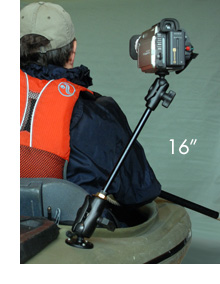Radpole™ Multipurpose Extension Arm

Choosing your Radpole height: 16, 25 or 31 inches?
The Radpole is available in three heights, 31" (79 cm), 25" (64 cm) and 16" (41 cm).
A shorter height supports cameras and accessories of greater weight, since the moment arm of the payload (i.e. the camera, videocam, etc.) is reduced.
You can purchase multiple Radpole arms of varying height with a single base to suit every possible contingency. Our testing makes it possible to make some practical recommendations so you can choose just one.

If you're an active paddler, your kayak will rock slightly with each paddlestroke, and will also experience movement around pitch and yaw axes. A video camera mounted atop a tall pole has a wide arc of swing relative to the rolling or pitching deck surface. Its video will capture this movement, so while height can be used to provide an exciting perpespective to videography, the increase in motion must be considered.
The Radpole is extraordinary because a camera hosted atop the pole can be positioned at an odd angle or even outwardly extended from the kayak on plane with the watersheet depending on the desired action to be captured.
For hosting a 31" Radpole (left, upper) on a kayak, our maximum recommended weight for a camera or other payload is 12 oz. (340 g). For a boat or more stable watercraft, greater payload weights up to 2 lbs. (908 g) are possible depending on the intended use.
During our testing, the 25" Radpole (left, middle) was generally the best match for a kayak. At this height, the navigation light is visible 360° across the watersheet. The 25" height provides strength for your camera and gear while capable of being positioned to maintain a stable, unobstructed view of the horizon. And the 25" arm is easily stowed or folded alongside the kayak for portage.
The 25" Radpole can also be angled slightly to the side of the kayak's centerline to provide an excellent perspective over the bow. For use on a kayak, the 25" Radpole is recommended to support payload weights up to 1 lb. (16 oz., 454 g). For a boat, payload weights up to 40 oz. (2.5 lbs., 1.13 kg) can be mounted, depending on the intended use.
If you are a paddler and intend to use the Radpole to host your GPS or other display unit, you may also consider adding a small Toughbar™ extension to the end of the Radpole — similar to the elbow of a dentist's drill, allowing you to position your display over your shoulder without impacting your paddlestroke.

The 16" Radpole can manage the most weight and forces acting upon it, but may be too short to position your camera or light above your head if you are seated in a kayak cockpit.
As shown at right, the 16" model can be angled to avoid obstruction. The 16" Radpole would be an excellent choice if you anticipate mounting it for photography from your kayak's foredeck rather than on the afterdeck. One reminder: If the Radpole is mounted on the foredeck, you may want to baffle the rear half of the navigation light to prevent impairment of your night vision.
For use on a kayak, the 16" Radpole is recommended to support heavier equipment — payload weights up to 20 oz., (567 g). For a boat, payload weights up to 48 oz. (3 lbs., 1.4 kg) can be mounted, depending on the intended use.
If you are using the Radpole on a sailboat, powerboat, sit-on-top kayak, or stand-up-paddle board, and you intend to use the navigation light, we'd generally recommend the 31" Radpole with a maximum payload (i.e. camera) of 12 ounces (340 g). A pole-mounted light of such height is not required for kayaks, SOTs or SUPs by the U.S. Coast Guard — but it's certainly a worthwhile feature to consider in areas with heavy boat traffic.
Keep in mind that your watercraft's deck may not be able to support the leveraged forces of heavy equipment, even if the Radpole can easily manage substantial force. For this reason, we recommend that paddlers and boaters consider using popular compact cameras and portable video equipment. For heavy equipment, consider constructing a Radpole tripod with three separate bases and a RAM Mounts triple-ball connector.
More Information about the Radpole
- Introduction
- General info about Radpole Assembly
- This Page: How to Determine the Correct Radpole Height
- About the Radpole's Aluminum Base
- Fishing Rod Holders for the Radpole Base
- The Radpole Flex, a Flexible Alternative
- Optional Radpole Accessories
- Radpole Specification Table




